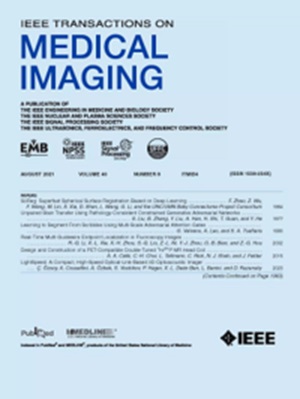用于多对比度MRI重建的耦合字典学习
IF 8.9
1区 医学
Q1 COMPUTER SCIENCE, INTERDISCIPLINARY APPLICATIONS
引用次数: 12
摘要
磁共振(MR)成像任务通常涉及多重对比,如t1加权、t2加权和流体衰减反演恢复(FLAIR)数据。这些对比捕获了与相同底层解剖结构相关的信息,因此在结构级别或灰度级别上表现出相似性。在本文中,我们提出了一种基于耦合字典学习的多对比MRI重建(CDLMRI)方法,利用不同对比之间的依赖相关性,从其欠采样的$k$空间数据中进行引导或联合重建。我们的方法在三个阶段之间迭代:耦合字典学习、耦合稀疏去噪和强制k空间一致性。第一阶段学习一组字典,这些字典不仅可以适应对比,还可以捕获稀疏变换域中多个对比之间的相关性。通过利用学习到的字典,第二阶段执行耦合稀疏编码,以消除损坏对比度中的混叠和噪声。第三阶段加强去噪对比度和k空间域中测量值之间的一致性。数值实验通过对不同采样方案下的不同MRI对比进行回顾性欠采样,证明了CDLMRI能够捕捉不同对比之间的结构依赖性。学习到的先验在多对比磁共振成像中具有显著的优势,在定量磁共振成像(如磁共振指纹识别)中具有广阔的应用前景。本文章由计算机程序翻译,如有差异,请以英文原文为准。
Coupled Dictionary Learning for Multi-Contrast MRI Reconstruction
Magnetic resonance (MR) imaging tasks often involve multiple contrasts, such as T1-weighted, T2-weighted and fluid-attenuated inversion recovery (FLAIR) data. These contrasts capture information associated with the same underlying anatomy and thus exhibit similarities in either structure level or gray level. In this paper, we propose a coupled dictionary learning based multi-contrast MRI reconstruction (CDLMRI) approach to leverage the dependency correlation between different contrasts for guided or joint reconstruction from their under-sampled $k$ -space data. Our approach iterates between three stages: coupled dictionary learning, coupled sparse denoising, and enforcing $k$ -space consistency. The first stage learns a set of dictionaries that not only are adaptive to the contrasts, but also capture correlations among multiple contrasts in a sparse transform domain. By capitalizing on the learned dictionaries, the second stage performs coupled sparse coding to remove the aliasing and noise in the corrupted contrasts. The third stage enforces consistency between the denoised contrasts and the measurements in the $k$ -space domain. Numerical experiments, consisting of retrospective under-sampling of various MRI contrasts with a variety of sampling schemes, demonstrate that CDLMRI is capable of capturing structural dependencies between different contrasts. The learned priors indicate notable advantages in multi-contrast MR imaging and promising applications in quantitative MR imaging such as MR fingerprinting.
求助全文
通过发布文献求助,成功后即可免费获取论文全文。
去求助
来源期刊

IEEE Transactions on Medical Imaging
医学-成像科学与照相技术
CiteScore
21.80
自引率
5.70%
发文量
637
审稿时长
5.6 months
期刊介绍:
The IEEE Transactions on Medical Imaging (T-MI) is a journal that welcomes the submission of manuscripts focusing on various aspects of medical imaging. The journal encourages the exploration of body structure, morphology, and function through different imaging techniques, including ultrasound, X-rays, magnetic resonance, radionuclides, microwaves, and optical methods. It also promotes contributions related to cell and molecular imaging, as well as all forms of microscopy.
T-MI publishes original research papers that cover a wide range of topics, including but not limited to novel acquisition techniques, medical image processing and analysis, visualization and performance, pattern recognition, machine learning, and other related methods. The journal particularly encourages highly technical studies that offer new perspectives. By emphasizing the unification of medicine, biology, and imaging, T-MI seeks to bridge the gap between instrumentation, hardware, software, mathematics, physics, biology, and medicine by introducing new analysis methods.
While the journal welcomes strong application papers that describe novel methods, it directs papers that focus solely on important applications using medically adopted or well-established methods without significant innovation in methodology to other journals. T-MI is indexed in Pubmed® and Medline®, which are products of the United States National Library of Medicine.
 求助内容:
求助内容: 应助结果提醒方式:
应助结果提醒方式:


